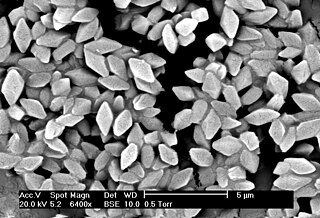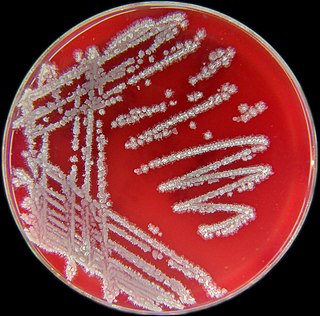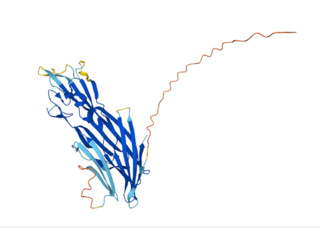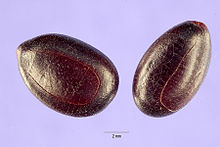
Bacillus thuringiensis is a gram-positive, soil-dwelling bacterium, the most commonly used biological pesticide worldwide. B. thuringiensis also occurs naturally in the gut of caterpillars of various types of moths and butterflies, as well on leaf surfaces, aquatic environments, animal feces, insect-rich environments, and flour mills and grain-storage facilities. It has also been observed to parasitize other moths such as Cadra calidella—in laboratory experiments working with C. calidella, many of the moths were diseased due to this parasite.

Bacillus is a genus of Gram-positive, rod-shaped bacteria, a member of the phylum Bacillota, with 266 named species. The term is also used to describe the shape (rod) of other so-shaped bacteria; and the plural Bacilli is the name of the class of bacteria to which this genus belongs. Bacillus species can be either obligate aerobes which are dependent on oxygen, or facultative anaerobes which can survive in the absence of oxygen. Cultured Bacillus species test positive for the enzyme catalase if oxygen has been used or is present.

Bacillus cereus is a Gram-positive rod-shaped bacterium commonly found in soil, food, and marine sponges. The specific name, cereus, meaning "waxy" in Latin, refers to the appearance of colonies grown on blood agar. Some strains are harmful to humans and cause foodborne illness due to their spore-forming nature, while other strains can be beneficial as probiotics for animals, and even exhibit mutualism with certain plants. B. cereus bacteria may be anaerobes or facultative anaerobes, and like other members of the genus Bacillus, can produce protective endospores. They have a wide range of virulence factors, including phospholipase C, cereulide, sphingomyelinase, metalloproteases, and cytotoxin K, many of which are regulated via quorum sensing. B. cereus strains exhibit flagellar motility.

Prosopis is a genus of flowering plants in the family Fabaceae. It contains around 45 species of spiny trees and shrubs found in subtropical and tropical regions of the Americas, Africa, Western Asia, and South Asia. They often thrive in arid soil and are resistant to drought, on occasion developing extremely deep root systems. Their wood is usually hard, dense and durable. Their fruits are pods and may contain large amounts of sugar. The generic name means "burdock" in late Latin and originated in the Greek language.

Nattō, spelled as natto in standard English language use, is a traditional Japanese food made from whole soybeans that have been fermented with Bacillus subtilis var. natto. It is often served as a breakfast food with rice. It is served with karashi mustard, soy or tare sauce, and sometimes Japanese bunching onion. Within Japan, nattō is most popular in the eastern regions, including Kantō, Tōhoku, and Hokkaido.

Bacillus subtilis, known also as the hay bacillus or grass bacillus, is a Gram-positive, catalase-positive bacterium, found in soil and the gastrointestinal tract of ruminants, humans and marine sponges. As a member of the genus Bacillus, B. subtilis is rod-shaped, and can form a tough, protective endospore, allowing it to tolerate extreme environmental conditions. B. subtilis has historically been classified as an obligate aerobe, though evidence exists that it is a facultative anaerobe. B. subtilis is considered the best studied Gram-positive bacterium and a model organism to study bacterial chromosome replication and cell differentiation. It is one of the bacterial champions in secreted enzyme production and used on an industrial scale by biotechnology companies.

Bacitracin is a polypeptide antibiotic. It is a mixture of related cyclic peptides produced by Bacillus licheniformis bacteria, that was first isolated from the variety "Tracy I" in 1945. These peptides disrupt gram-positive bacteria by interfering with cell wall and peptidoglycan synthesis.

An enterotoxin is a protein exotoxin released by a microorganism that targets the intestines.

Sumbala or soumbala is a fermented seed condiment used widely across West Africa. It is usually prepared by women over the course of several days, traditionally from 'néré seeds. It can be made from other kinds of seeds, such as those of Prosopis africana, and the use of soybeans for this purpose is increasing due mainly to inadequate supply of néré seeds. It is comparable to miso paste.

Bacillus licheniformis is a bacterium commonly found in the soil. It is found on bird feathers, especially chest and back plumage, and most often in ground-dwelling birds and aquatic species.

Aeromonas hydrophila is a heterotrophic, Gram-negative, rod-shaped bacterium mainly found in areas with a warm climate. This bacterium can be found in fresh or brackish water. It can survive in aerobic and anaerobic environments, and can digest materials such as gelatin and hemoglobin. A. hydrophila was isolated from humans and animals in the 1950s. It is the best known of the species of Aeromonas. It is resistant to most common antibiotics and cold temperatures and is oxidase- and indole-positive. Aeromonas hydrophila also has a symbiotic relationship as gut flora inside of certain leeches, such as Hirudo medicinalis.

Aeschynomene elaphroxylon, also known as an ambatch, pith-tree, balsa wood tree, or umburu, is a common large shrub to small tree of the genus Aeschynomene in the family Fabaceae growing in swamps, lakes and rivers in Tropical Africa. It grows two to nine, exceptionally up to twelve, metres high, with a straight, thick, swollen, conical trunk. This is an unusual leguminous tree in that it grows in water as a freshwater mangrove, with an extremely lightweight wood acting as a float and a specialised root system sprouting from the trunk which forms a tangled web hanging through the water and sprawling through the mud. It has adventitious roots and roots which are differentiated into special structures adapted to the swamp environment. It can even grow as floating islands of drifting forests.

Bacillus anthracis is a gram-positive and rod-shaped bacterium that causes anthrax, a deadly disease to livestock and, occasionally, to humans. It is the only permanent (obligate) pathogen within the genus Bacillus. Its infection is a type of zoonosis, as it is transmitted from animals to humans. It was discovered by a German physician Robert Koch in 1876, and became the first bacterium to be experimentally shown as a pathogen. The discovery was also the first scientific evidence for the germ theory of diseases.

Meju (메주) is a brick of dried fermented soybeans. While not consumed on its own, it serves as the basis of several Korean condiments, such as doenjang, ganjang, and gochujang. Meju is produced by pounding, kneading, and shaping cooked soybeans, and undergoes fermentation with Aspergillus oryzae and/or Bacillus subtilis.
In molecular biology, the Bacillus haemolytic enterotoxin family of proteins consists of several Bacillus haemolytic enterotoxins, which can cause food poisoning in humans. Haemolysin BL and non-haemolytic enterotoxin, represent the major enterotoxins produced by Bacillus cereus. Most of the cytotoxic activity of B. cereus isolates has been attributed to the level of Nhe, which may indicate a highly diarrheic potential. The exact mechanism by which B. cereus causes diarrhoea is unknown. Hbl, cytotoxin K (CytK) and Nhe are all putative causes.

Detarium microcarpum, commonly known as sweet detar, sweet dattock or tallow tree, is an underutilized species of tree legume that grows naturally in the drier regions of West and Central Africa. It has a wide range of uses due to its medicinal properties, edible fruit and hardwood, which is used as fuel. This makes it valuable and appreciated by local communities, but further research and effort are needed for its domestication.
Bacillolysin is an enzyme. This enzyme catalyses the following chemical reaction

Okoho is the main traditional food peculiar to the Idoma people of Benue State, Central Nigeria. It is made from the plant Cissus populnea belonging to the family Amplidaceae (Vitaceae).
Ramesh Chandra Ray is an agriculture and food microbiologist, author, and editor. He is the former Principal Scientist (Microbiology), and Head of the Regional Centre at Indian Council of Agricultural Research ICAR - Central Tuber Crops Research Institute in Bhubaneswar, India.

Cytotoxin-K (CytK) is a protein toxin produced by the gram-positive bacteria Bacillus cereus. It was first discovered in a certain Bacillus cereus strain which was isolated from a food poisoning epidemic that occurred in a French nursing home in 1998. There were six cases of bloody diarrhea, three of which were fatal. None of the known enterotoxins from B. cereus could be detected at this time. Later, this B. cereus strain and its relatives were classified as a brand-new species called Bacillus cytotoxicus, which is the thermo-tolerant member of the B. cereus genus. The cytotoxin-K gene is present in approximately 50% of Bacillus cereus isolates, and its expression is regulated by several factors, including temperature and nutrient availability.


















